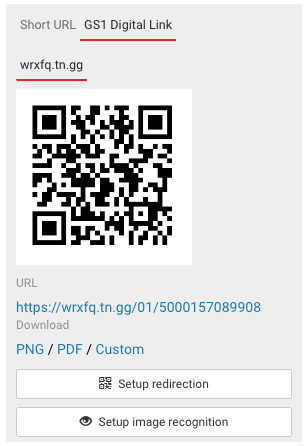Adding a GS1 Digital Link
Now that the projects, products, and redirections for your products have been set up in an EVRYTHNG account, the next step in increasing the value for your brand and consumers is to replace the short-URL QR code with one that contains a GS1 Digital Link.
This new standard encodes GS1 Application Identifiers such as GTIN (01) or Serial (21), with a URL that contains the equivalent data. This URL is much more valuable because it can be systematically read by a Point-of-Sale (PoS) or inventory management system, as well as a consumer's mobile phone, and redirect to a dynamic experience using the EVRYTHNG Platform. To discover more about the Digital Link, see our playground.
Setting up a GS1 Digital Link for your products takes only a few steps:
- Ensure a redirection is set for the product.
- Set up GS1 AI data on an EVRYTHNG product.
- If serialized Digital Links are required, set up AI data on each individual product Thng.
Check Redirection
To create a GS1 Digital Link, the product must first have a redirection that describes the experience or web app that a user scanning QR code will be taken to. A common example is a web page showing product-specific nutritional or safety information.
If the product you want to add a Digital Link to doesn't currently have a redirection set (that is, no QR codes are visible in its Product Details page on the Dashboard), follow the steps in Redirections and Actions to set one up before you continue.
SKU Level Digital Links on Products
A GS1 Digital Link that uses the EVRYTHNG Platform can support several of the most common GS1 application identifiers, describing data about the product, such as its GTIN or CPV numbers.
A simple EVRYTHNG GS1 Digital Link contains just one of these identifiers, but for the full value of serialized identities to be applied to this area, each Thng that links to a product with a GTIN must also have a GS1 serial number. For the purposes of this walkthrough, both cases are covered.
The first step is to add the correct namespace identifiers for the GTIN (01) to your product using its id. Here, we assume it currently has no identifiers:
curl -H "Content-Type: application/json" \
-H "Authorization: $OPERATOR_API_KEY" \
-X PUT 'https://api.evrythng.io/v2/products/:productId' \
-d '{
"identifiers": {
"gs1:01": "05000157089906"
}
}'After the request is complete, you can see the 'GS1 Digital Link' tab on the right side of the Product Details page, containing the product's Digital Link URL and equivalent QR code. Note that you can also set these identifiers through the Dashboard.

The product now has its own GS1 Digital Link with a QR code ready to print on packaging. You can change the URL the redirection points to at any time or use Redirector rules to make it a dynamic destination based on factors such as locale, time, extra data, and so on.
Serialized GS1 Digital Links on Thngs
After a Thng's product has its GTIN information set up, a similar item must be added to each Thng's identifiers to set its GS1 Serial number (21). If you're using the serialized mode of GS1 Digital Link, ensure that the Thng's redirection is set up first.
curl -H "Content-Type: application/json" \
-H "Authorization: $OPERATOR_API_KEY" \
-X PUT 'https://api.evrythng.io/v2/thngs/:thngId' \
-d '{
"identifiers": {
"gs1:21": "43786"
}
}'After the Thng has been updated and its product correctly configured with a GTIN, the Thng Details page on the Dashboard shows a similar view of the GS1 Digital Link for the Thng on the right side:

Wrapping Up
This walkthrough has provided insight into how the basic resource types of the EVRYTHNG Platform can play a useful role in an example tagged products scenario. In summary:
- Projects are used to limit access and visibility of resources.
- Applications represent remote apps/integrations, and are used to give access to users of the app.
- Products represent classes of objects, and are used to share metadata across instances.
- Thngs are the main data containers and are the physical counterpart of real-world objects, products, and devices.
- Actions represent discrete events or alerts/notifications.
- Dashboard widgets can be customized to display insightful summaries of actions by their various types and locations.
- You've seen how to add two more pieces of data to unlock a GS1 Digital Link QR code for use on universal packaging.
Updated 7 months ago
